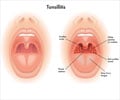Children who are more susceptible to strep throat infection benefit by undergoing tonsillectomy,according to a Mayo clinic study.
Children whose tonsils have not been removed are over three times more likely to develop subsequent episodes of strep throat than children who undergo tonsillectomy. ."These results suggest that tonsillectomy is a useful therapy for treating children with recurrent strep throat infections," says Laura Orvidas, M.D., Mayo Clinic ear, nose and throat surgeon and senior study investigator. "It should decrease the amount of infections experienced by this subset of children and therefore diminish the number of missed school days and hopefully improve overall quality of life."
Dr. Orvidas and colleagues conducted a population-based retrospective cohort study of children between ages 4 and 16 who received three or more diagnoses of strep-related tonsillitis or pharyngitis at least one month apart, within 12 months. Within this group, children who subsequently underwent a tonsillectomy were compared with an age- and sex-matched sample of children who had not had a tonsillectomy. The date of the tonsillectomy for the matched pair was defined as the index date. All strep infections were recorded for both groups of children.
The study population comprised 290 children (145 who received a tonsillectomy and 145 who did not). In the tonsillectomy group, 74 children experienced at least one strep infection after the index date and before age 16. Among those who did not receive a tonsillectomy, 122 experienced at least one strep infection during the follow-up. The time before first subsequent strep infection was much longer for those who had a tonsillectomy, a median of 1.1 years as compared to 0.6 years for children whose tonsils had not been removed. By one year after the index date, the cumulative incidence of a strep infection was 23.1 percent among the children who had a tonsillectomy compared to 58.5 percent among the children who had not.
Researchers used the Rochester Epidemiology Project to identify children for the study, which was limited to children who resided in Olmsted County, Minn., between Jan. 1, 1994, and Dec. 31, 1998. The Rochester Epidemiology Project has developed an index for the records of virtually all providers of medical care in Olmsted County. Olmsted County is served by a largely unified medical care system, including Mayo Clinic, that has accumulated comprehensive clinical records since the early 1900s.
"The use of the Rochester Epidemiology Project resource was unquestionably one of the strengths of the study," says Dr. Orvidas. "This resource allowed us to access complete medical records on a geographically defined pediatric population and minimized potential referral and participation biases."
Advertisement
Pharyngitis and tonsillitis are among the most commonly diagnosed pediatric illnesses, accounting for approximately 18 million physician office visits per year. Strep infections are responsible for 15 percent to 30 percent of all cases of pharyngitis. In addition, 20 percent to 30 percent of children who are diagnosed with strep pharyngeal infection may experience a second infection within 60 days of the initial episode.
Advertisement
SRM








